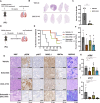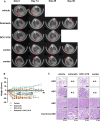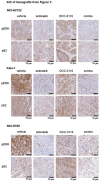Inhibition of ULK1/2 and KRASG12C controls tumor growth in preclinical models of lung cancer
- PMID: 39213022
- PMCID: PMC11364435
- DOI: 10.7554/eLife.96992
Inhibition of ULK1/2 and KRASG12C controls tumor growth in preclinical models of lung cancer
Abstract
Mutational activation of KRAS occurs commonly in lung carcinogenesis and, with the recent U.S. Food and Drug Administration approval of covalent inhibitors of KRASG12C such as sotorasib or adagrasib, KRAS oncoproteins are important pharmacological targets in non-small cell lung cancer (NSCLC). However, not all KRASG12C-driven NSCLCs respond to these inhibitors, and the emergence of drug resistance in those patients who do respond can be rapid and pleiotropic. Hence, based on a backbone of covalent inhibition of KRASG12C, efforts are underway to develop effective combination therapies. Here, we report that the inhibition of KRASG12C signaling increases autophagy in KRASG12C-expressing lung cancer cells. Moreover, the combination of DCC-3116, a selective ULK1/2 inhibitor, plus sotorasib displays cooperative/synergistic suppression of human KRASG12C-driven lung cancer cell proliferation in vitro and superior tumor control in vivo. Additionally, in genetically engineered mouse models of KRASG12C-driven NSCLC, inhibition of either KRASG12C or ULK1/2 decreases tumor burden and increases mouse survival. Consequently, these data suggest that ULK1/2-mediated autophagy is a pharmacologically actionable cytoprotective stress response to inhibition of KRASG12C in lung cancer.
Keywords: KRAS; LKB1; TP53; ULK; autophagy; cancer biology; lung cancer; mouse.
© 2024, Ghazi et al.
Conflict of interest statement
PG, KO, SS, MS, MS, YZ, GL, ES No competing interests declared, MB, BS, DF stockholder of Deciphera Pharmaceuticals, CK, MM Research described here was supported through a Sponsored Research Agreement between the University of Utah and Deciphera Pharmaceuticals award to MM and CK
Figures














Update of
-
Inhibition of ULK1/2 and KRAS G12C controls tumor growth in preclinical models of lung cancer.bioRxiv [Preprint]. 2024 Jun 17:2024.02.06.579200. doi: 10.1101/2024.02.06.579200. bioRxiv. 2024. Update in: Elife. 2024 Aug 30;13:RP96992. doi: 10.7554/eLife.96992. PMID: 38370808 Free PMC article. Updated. Preprint.
References
-
- Ahrendt SA, Decker PA, Alawi EA, Zhu Yr YR, Sanchez-Cespedes M, Yang SC, Haasler GB, Kajdacsy-Balla A, Demeure MJ, Sidransky D. Cigarette smoking is strongly associated with mutation of the K-ras gene in patients with primary adenocarcinoma of the lung. Cancer. 2001;92:1525–1530. doi: 10.1002/1097-0142(20010915)92:6<1525::aid-cncr1478>3.0.co;2-h. - DOI - PubMed
-
- Amaravadi RK, Kimmelman AC, Debnath J. Targeting autophagy in cancer: Recent advances and future directions. Cancer Discovery. 2019;9:1167–1181. doi: 10.1158/2159-8290.CD-19-0292. - DOI - PMC - PubMed
MeSH terms
Substances
Grants and funding
- K08CA230151/CA/NCI NIH HHS/United States
- K08 CA230151/CA/NCI NIH HHS/United States
- T32 CA265782/CA/NCI NIH HHS/United States
- R01 CA131261/CA/NCI NIH HHS/United States
- R01CA82577/CA/NCI NIH HHS/United States
- UM1 TR004409/TR/NCATS NIH HHS/United States
- R01CA176839/CA/NCI NIH HHS/United States
- R01CA212415/CA/NCI NIH HHS/United States
- P30CA042014/CA/NCI NIH HHS/United States
- R01 CA240317/CA/NCI NIH HHS/United States
- R01 CA237404/CA/NCI NIH HHS/United States
- P30 CA042014/CA/NCI NIH HHS/United States
- R01CA237404/CA/NCI NIH HHS/United States
- R01CA131261/CA/NCI NIH HHS/United States
- R01 CA176839/CA/NCI NIH HHS/United States
- F31 CA261116/CA/NCI NIH HHS/United States
- R01 CA082577/CA/NCI NIH HHS/United States
- R01 CA212415/CA/NCI NIH HHS/United States
- R01CA240317/CA/NCI NIH HHS/United States
- F31CA261116/CA/NCI NIH HHS/United States
LinkOut - more resources
Full Text Sources
Medical
Molecular Biology Databases
Research Materials
Miscellaneous

